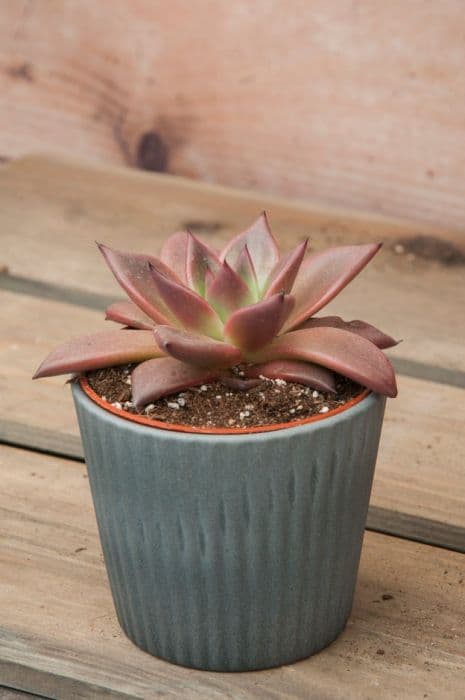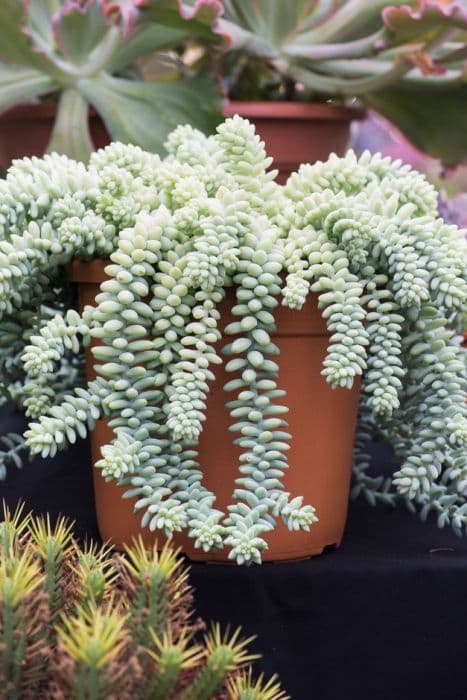Tree Houseleek Aeonium arboreum

ABOUT
Aeonium arboreum, commonly known as the tree houseleek, has a distinct appearance characterized by its succulent attributes. This plant features rosettes of fleshy, waxy leaves that often grow in a spiral pattern and can vary in color from deep green to burgundy, sometimes with a glossy or matte finish. Each rosette appears almost like a large, singular flower composed of spoon-shaped leaves. The plant has a branching habit, with stems that bear the rosettes at their ends, resembling a tree-like structure. During certain seasons, the tree houseleek may produce pyramidal clusters of small, star-shaped flowers. These blooms can range in color, typically yellow, adding a vibrant contrast to the foliage. The overall aesthetic is one of sculptural, geometric forms, making it a popular choice in succulent gardens and as an ornamental plant in various landscapes.
About this plant
 Names
NamesFamily
Crassulaceae.
Synonyms
Tree Aeonium, Tree Houseleek, Irish Rose.
Common names
Sempervivum arboreum, Aeonium manriqueorum, Aeonium arboreum var. holochrysum, Aeonium arboreum var. albovariegatum, Aeonium arboreum var. rubrolineatum, Aeonium arboreum var. atropurpureum, Aeonium arboreum var. arboreum.
 Toxicity
ToxicityTo humans
The Aeonium arboreum, commonly known as tree aeonium, is not toxic to humans. Therefore, if ingested, there should not be any symptoms of poisoning from this plant. However, as with any plant, individuals may have varying sensitivities, and it is always recommended to avoid ingesting plants that are not specifically intended for consumption. If ingested in large quantities or if an individual has particular sensitivities, gastrointestinal discomfort or other adverse reactions could potentially occur.
To pets
Tree aeonium is generally not considered toxic to pets such as dogs and cats. There should not be any symptoms of poisoning in pets if they ingest parts of the Aeonium arboreum. However, individual pets may have different reactions to ingesting plants, and some may experience mild gastrointestinal upset. It is always recommended to keep an eye on your pets and prevent them from consuming plants that are not meant to be eaten, as a precautionary measure.
 Characteristics
CharacteristicsLife cycle
Perennials
Foliage type
Evergreen
Color of leaves
Varies
Flower color
Yellow
Height
3 feet (0.91 meters)
Spread
2 feet (0.61 meters)
Plant type
Succulent
Hardiness zones
9
Native area
Canary Islands
Benefits
 General Benefits
General Benefits- Decorative Appeal: Aeonium arboreum, commonly known as the Tree Houseleek, has rosettes of waxy leaves that add unique texture and a splash of color to gardens and indoor spaces.
- Drought Tolerance: As a succulent, it is highly drought-resistant, ideal for water-wise landscaping and for gardeners in arid climates or with water restrictions.
- Low Maintenance: It requires minimal care, making it a great choice for busy or beginner gardeners who want an easy-to-care-for plant.
- Attracts Pollinators: While in bloom, Aeonium arboreum can attract bees and other pollinators to the garden, supporting local ecosystems.
- Adaptability: It can grow in a variety of soil types, as long as they have good drainage, and is tolerant of a range of sunlight exposure, from full sun to partial shade.
- Propagation Ease: Easy to propagate from cuttings, making it simple for gardeners to create more plants for use in other areas or to share with friends.
- Seasonal Interest: Its striking foliage and the occasional bloom cycles provide year-round visual interest, varying based on the season and conditions.
- Versatility in Landscaping: Can be used in various design settings, such as rock gardens, Mediterranean gardens, or as container plants for patios and balconies.
 Medical Properties
Medical PropertiesThis plant is not used for medical purposes.
 Air-purifying Qualities
Air-purifying QualitiesThis plant is not specifically known for air purifying qualities.
 Other Uses
Other Uses- Ornamental Display: Aeonium arboreum, commonly known as "tree houseleek," can be used as a striking centerpiece in succulent arrangements due to its rosette shape and deep green color.
- Green Roofs: Tree houseleek can be planted on green roofs for its low-water needs and ability to withstand full sun, contributing to urban biodiversity and insulation.
- Water Conservation: These drought-tolerant plants are great for xeriscaping, a landscaping method that reduces the need for supplemental water from irrigation.
- Coastal Landscaping: Tree houseleek is well-suited to seaside gardens as it can handle the salty air and often windy conditions of coastal climates.
- Rock Gardens: Their ability to grow in rocky, poor soil makes the tree houseleek an excellent choice for rock garden enthusiasts.
- Container Gardening: As a plant that does well in containers, tree houseleek can be used to decorate patios, balconies, and other small outdoor spaces.
- Erosion Control: The root systems of these succulents can help stabilize soil on slopes, thus aiding in the prevention of erosion.
- Photography Prop: Due to its unique appearance, tree houseleek often serves as a photogenic prop or subject for photographers, especially in macro photography.
- Educational Tool: Botany educators may use tree houseleek to teach about succulent plant adaptations like water storage in leaves and CAM photosynthesis.
- Garden Art: The distinct rosette pattern and structure of the tree houseleek allow for their use in living garden art pieces and succulent sculptures.
Interesting Facts
 Feng Shui
Feng ShuiThe Aeonium arboreum, commonly known as the Tree Aeonium, is not typically referenced in Feng Shui practice.
 Zodiac Sign Compitability
Zodiac Sign CompitabilityThe Tree Aeonium is not used in astrology practice.
 Plant Symbolism
Plant Symbolism- Resilience: Aeonium arboreum, commonly known as the Tree Houseleek, possesses a natural ability to withstand drought by storing water in its leaves. This characteristic symbolizes resilience and adaptability in tough conditions.
- Eternal Life: With its evergreen appearance and ability to easily propagate from cuttings, the Tree Houseleek represents the concept of eternal life, renewal, and continuity.
- Protection: Historically, Tree Houseleeks were planted on roofs to protect against lightning and fire, translating into a broader symbolism of general protection and guardianship.
- Uniqueness: Aeonium arboreum features rosettes of waxy leaves in a unique array of colors and patterns, which celebrates individuality and the beauty of being unique.
- Prosperity and Wealth: Due to its succulent nature and tendency to produce abundant, lush rosettes, it is sometimes linked to prosperity, wealth, and growth.
 Water
WaterThe Tree Aeonium, or Aeonium arboreum, should be watered sparingly and allowed to dry out between waterings as it is susceptible to root rot if kept too moist. During the growing season, which is generally from fall to spring, water the plant approximately once a week with about 8-10 ounces of water, adjusting for climate and indoor conditions. In the summer, when the plant is dormant, water even less frequently, providing just enough to prevent the leaves from shriveling, about once every two to three weeks. It’s important to avoid watering directly into the rosette as this can cause rot, instead water the soil directly. Ensure the pot has good drainage to avoid standing water.
 Light
LightTree Aeonium thrives in bright, indirect sunlight and should be placed in a spot where it can receive at least six hours of sunlight daily, but protected from harsh midday sun which can scorch the leaves. An east or west-facing window is ideal for providing the right light conditions inside a home. If grown outdoors, semi-shaded areas that mimic their natural habitat work best, especially in hot climates.
 Temperature
TemperatureTree Aeonium prefers mild temperatures and does best in a range from 40 to 100 degrees Fahrenheit. They can survive brief periods of colder weather down to around 30 degrees Fahrenheit, but prolonged exposure can be harmful. The ideal temperatures for promoting growth are between 65 and 75 degrees Fahrenheit. This succulent is not frost-tolerant and should be protected or moved indoors during cold winters.
 Pruning
PruningTree Aeonium benefits from occasional pruning to encourage a fuller shape and to remove any leggy or overgrown stems. The best time to prune is in the growing season, typically fall to spring. You can prune as often as needed to maintain shape but avoid over-pruning as it may stress the plant. Cuttings taken during pruning can often be used for propagation.
 Cleaning
CleaningAs needed
 Soil
SoilThe best soil mix for Tree Aeonium should be well-draining and sandy. A mixture of cactus potting soil with perlite or pumice can create the ideal growing environment. Slightly acidic to neutral pH, ranging from 6.0 to 7.0, is optimal for the health of the Tree Aeonium.
 Repotting
RepottingTree Aeoniums should be repotted every two to three years, or when they outgrow their current container. The best time to repot is during their dormant period, which is typically after the flowering season.
 Humidity & Misting
Humidity & MistingTree Aeonium prefers a dry climate and does well in low humidity conditions. They are well-suited to arid environments, so it is best to avoid high humidity to minimize the risk of rot.
 Suitable locations
Suitable locationsIndoor
Place Tree Aeonium in bright, indirect light indoors.
Outdoor
Grow Tree Aeonium in full to partial sun outdoors.
Hardiness zone
9-11 USDA
 Life cycle
Life cycleThe life cycle of the Aeonium arboreum, commonly known as the tree aeonium or houseleek tree, begins as a seed, which requires well-drained soil and adequate sunlight to germinate. Upon sprouting, the seedling grows into a succulent with a rosette of leaves, which further develops into a mature plant with a branching, woody stem. As it matures, the tree aeonium produces clusters of yellow, star-shaped flowers at the ends of the branches, typically blooming in late winter to spring. After pollination, which is often aided by insects, the flowers develop into seed capsules containing numerous tiny seeds. Post flowering, particularly after a significant bloom, mature rosettes may die, but the plant continues to grow by forming new rosettes on other branches. The tree aeonium is a monocarpic species, meaning that individual rosettes will die after flowering, but since the plant is branching, not all rosettes will necessarily flower at once, allowing the plant to live for several years.
 Propogation
PropogationPropogation time
Spring to early summer
The Aeonium arboreum, commonly known as the Tree Aeonium or Tree Houseleek, is mostly propagated through stem cuttings. This method is popular due to its simplicity and effectiveness. The best time to propagate is during its active growth period, which is typically in spring or early summer. To propagate by stem cuttings, you should select a healthy, mature stem and cut a segment approximately 2 to 4 inches (5-10 cm) long using a clean, sharp knife or scissors. The cut end should be allowed to callous over for a few days to prevent rot when planted. Once calloused, the stem can be placed in well-draining soil and kept in a warm spot with indirect sunlight, ensuring that the soil remains moist but not waterlogged. Roots will typically develop within a few weeks, after which the new plant can gradually be acclimated to more direct sunlight.









